Connie Barlow undertook this Torreya quest with the assistance of Napa resident Jim O'Loughlin, but Jim was unable to follow me up the very steep, trail-less slope.
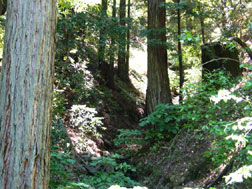 1a
1a
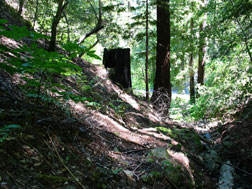 1b
1b
PHOTO 1a: View from the road of the only ravine that I had time to explore along Diamond Mountain Road. I noticed a small Torreya growing at the road pull-out, so this is why I chose to look here.Note: All these lands are privately owned, in large, mostly uninhabited private estates. I justify my initial trespass as a brief reconnaissance trip simply for finding a representative grove, but future visits should be undertaken with the approval of the landowner.
The ravine faces eastward, and I found Torreya growing up both the north and south-facing slopes. I could ascend only about 50 feet on the north-facing slope before the slope became too steep for me to safely negotiate. On the south-facing slope, I was able to top out on the sloping ridge (maybe 300 vertical feet higher than where I entered the ravine from the road) and exit to the road via an old logging trail that followed a gentler ravine. I found Torreya in that ravine, too.
PHOTO 1b: View from the ravine bottom, looking back toward road (slightly visible). Flowing water is visible lower right, as this had been a very wet winter and spring. Notice the same large stump of a logged redwood in both photos.
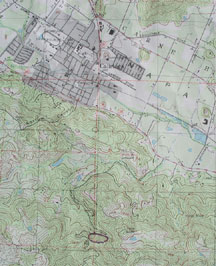 2a
2a
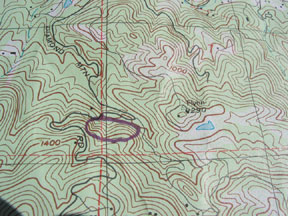 2b
2b
PHOTO 2a & 2b: A purple circle delineates the area I explored on foot. Diamond Mountain Road is south of the town of Calistoga, in the mountains that bound the northwest part of Napa Valley. This particular ravine is easily accessed along Diamond Mountain Road, 100 feet downhill from milemarker 1.25 (1.25 miles down from the county line at the summit of the watershed divide). The adjacent, gentler ravine through which I exited back to the road can be accessed by turning off Diamond Mountain Road onto South Fork Road. Drive 50 feet and park at first pullout on the right. There are 2 old logging roads visible here. Take the one on the left. The elevation from the lowest to highest Torreyas I examined on this particular sojourn was approximately 1000 to 1300 feet above sea level. The map uses 40-foot contour intervals.
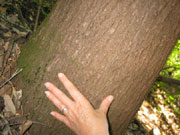 3a
3a
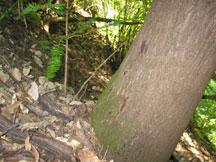 3b
3b
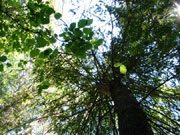 3c
3c
PHOTO 3a, 3b, 3c: This was by far the largest-diameter Torreya I found in either of the two ravines. This apparently healthy Torreya is growing on the north-facing slope, about 30 vertical feet above the creek, and perhaps 40 feet in from the road. The slope is very steep, and very bare of undergrowth. Although it was close to noon on a bright sunny day, I had to use a flash to take a picture of the lower trunk. In photo 3b, notice the greenery of the tiny stump sprout on the uphill side of it. Photo 3c is the view up into its canopy from the base of it. Although it was impossible to see the top, I did not see any fruit growing.
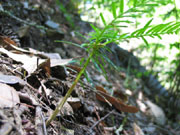 4a
4a
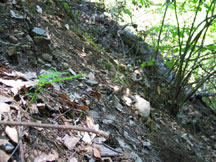 4b
4b
PHOTO 4a & 4b: This was the only seedling I found on the north-facing slope, and possibly the only one in the entire ravine. It was not associated with any other living or dead stem. In Photo 4b the seedling appears in lower left, and the steepness of the slope is apparent.
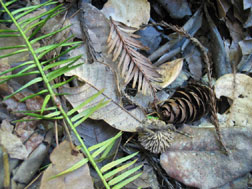 5
5
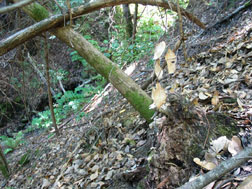 6a
6a
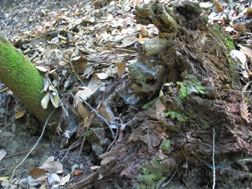 6b
6b
PHOTO 5: Typical forest floor on the north-facing slope, with a fallen Torreya branch, fallen redwood branch, Douglas fir cone, and cap of an acorn grouped together.PHOTO 6a: Steepness and barrenness of slope visible, down to the greenery of the narrow ravine bottom. An unidentified (probably Torreya) dead stem hangs over a down-slope leaning, living Torreya.
PHOTO 6b: The living Torreya in 6a was associated with a large, uplifted bundle of old rootstock/lignotuber, visible to the immediate right of it, indicating that the stem began as a stump sprout from perhaps several generations of previous stems from the same rootstock.
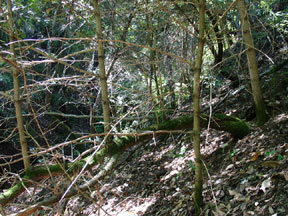 7a
7a
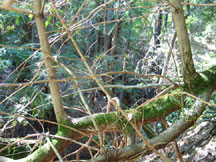 7b
7b
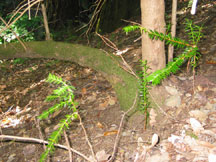 7c
7c
PHOTO 7a & 7b: A living, very mossy Torreya stem bent horizontally downslope, with abundant vertical stems emerging from it. This would be a good strategy to maximally find sunlight from a single rootstock.PHOTO 7c: The base of the same, deeply bent Torreya, showing several small stump sprouts with green foliage. (flash photo)
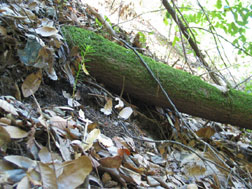 8
8
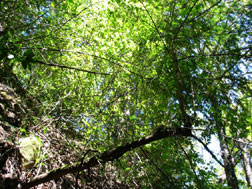 9
9
PHOTO 8: Another horizontally growing living stem.PHOTO 9: A horizontally trending stem abruptly ending in the dense foliage of a vertical offshoot that has found a patch of sunlight.
2. North-Facing Slope
(moderately steep; upper reaches more heavily vegetated
because beyond the shade of tall redwoods and Douglas fir)
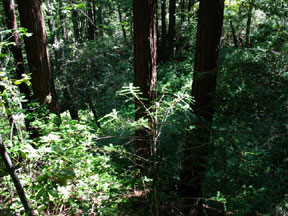 10
10
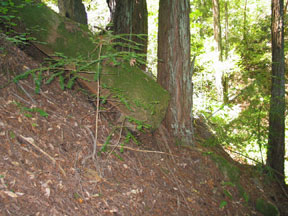 11
11
PHOTO 10: Looking down on redwoods at bottom of ravine. Young Torreya at center.PHOTO 11: Young Torreya in front of fallen log, with redwoods behind. Notice 1 or 2 small stump sprouts at its base. (flash photo)
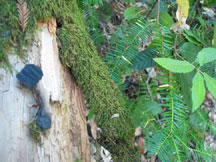 12
12
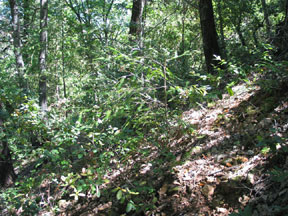 13
13
PHOTO 12: A fallen log with underside burned, alongside a branch of a small Torreya. I placed a charred piece of wood onto the log, which I found lying next to it. If the fire could be dated, this would probably correlate with a prior spurt of Torreya stems regenerating from rootstock, and that had an opportunity to grow tall and perhaps even to fruit before being shaded out by regrowths of redwood and Douglas Fir.PHOTO 13: A bushy small Torreya in a patch of sunlight near the top of the ridge.
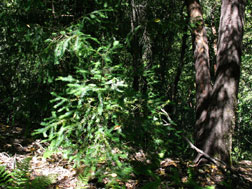 14
14
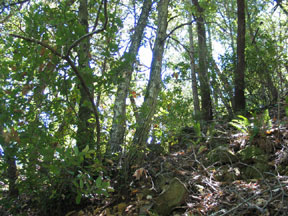 15
15
PHOTO 14: A young Torreya grown bushy in a patch of sunlight uphill from the big Douglas Fir (immediately behind) and the huge 2-stemmed madrone to the far right. The large redwoods are below the Douglas Fir level, very near the ravine bottom.PHOTO 15: View upslope from that same Torreya. Tall conifers drop out, and the oaks and bay laurel take over, with slim and rather short trunks. Far more sunlight penetrates here, and sapling Douglas fir begin to appear a little further upslope.
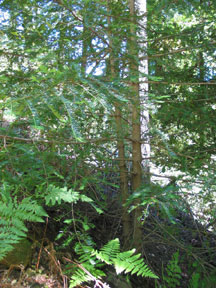 16a
16a
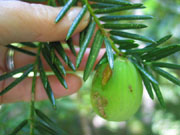 16b
16b
PHOTO 16a & 16b: The only tree I could see in "fruit" on this entire hike was growing in the gentler, south-facing ravine on the other side of the ridge, after I topped out from the north-facing slope pictured immediately above. This 2-stemmed female found a good patch of sunlight by growing right next to the old logging road (on which I was standing to take this picture). Its fruits were on the sunny branches, and one was low enough for me to reach its branch with my walking stick and bend it down for a photograph.
RETURN TO California Torreya Main Page.